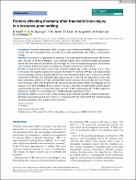| dc.contributor.author | Okidi, Ronald | |
| dc.contributor.author | Ogwang, Martin David | |
| dc.contributor.author | Okello, Tom Richard | |
| dc.contributor.author | Ezati, Daniel | |
| dc.contributor.author | Kyegombe, W. | |
| dc.contributor.author | Nyeko, D. | |
| dc.contributor.author | Scolding, N. J. | |
| dc.date.accessioned | 2021-05-12T10:43:47Z | |
| dc.date.available | 2021-05-12T10:43:47Z | |
| dc.date.issued | 2019 | |
| dc.identifier.citation | Okidi, R., Ogwang, D. M., Okello, T. R., Ezati, D., Kyegombe, W., Nyeko, D., & Scolding, N. J. (2019). Factors affecting mortality after traumatic brain injury in a resource-poor setting. BJS Open, 4(2), 320–325. https://doi.org/10.1002/bjs5.50243 | en_US |
| dc.identifier.uri | https://doi.org/10.1002/bjs5.50243 | |
| dc.identifier.uri | https://hdl.handle.net/123456789/251 | |
| dc.description.abstract | Background:
Traumatic brain injury (TBI) is a major cause of long-term disability and economic loss to
society. The aim of this study was to assess the factors affecting mortality after TBI in a resource-poor
setting.
Methods: Chart review was performed for randomly selected patients who presented with TBI between
2013 and 2017 at St Mary’s Hospital, Lacor, northern Uganda. Data collected included demographic
details, time from injury to presentation, and vital signs on arrival. In-hospital management and mortality
were recorded. Severe head injury was dened as a Glasgow Coma Scale score below 9.
Results: A total of 194 patient charts were reviewed. Median age at time of injury was 27 (i.q.r.
2–68) years. The majority of patients were male (M : F ratio 4⋅9 : 1). Some 30⋅9 per cent of patients had
severe head injury, and an associated skull fracture was observed in 8⋅8 per cent. Treatment was mainly
conservative in 94⋅8 per cent of patients; three patients (1⋅5 per cent) had burr-holes, four (2⋅1 per cent)
had a craniotomy, and three (1⋅5 per cent) had skull fracture elevation. The mortality rate was 33⋅0per
cent; 46 (72 per cent) of the 64 patients who died had severe head injury. Of the ten surgically treated
patients, seven died, including all three patients who had a burr-hole. In multivariable analysis, factors
associated with mortality were mean arterial pressure (P = 0⋅012), referral status (P = 0⋅001), respiratory
distress (P = 0⋅040), severe head injury (P = 0⋅011) and pupil reactivity (P = 0⋅011).
Conclusion: TBI in a resource-poor setting remains a major challenge and affects mainly young males.
Decisions concerning surgical intervention are compromised by the lack of both CT and intracranial
pressure monitoring, with consequent poor outcomes | en_US |
| dc.language.iso | en | en_US |
| dc.publisher | BJS Open | en_US |
| dc.subject | traumatic brain injury | en_US |
| dc.title | Factors affecting mortality after traumatic brain injury in a resource-poor setting | en_US |
| dc.type | Article | en_US |

